Elizabeth Taylor: the last great movie star might be her epitaph. One thinks of her great roles, both on and off the screen, and her jewels, and her costumes. One thinks of Edith Head when thinking of Elizabeth Taylor’s costumes, A Place in the Sun, perhaps. But it was Helen Rose at MGM that created Elizabeth’s formative and most striking gowns and wardrobe pieces. In this post we will explore some of these costumes and film fashions designed during Hollywood’s golden age.
This is another in a series of Silver Screen Modes dual portrais of stars and the unique relationships they developed with certain designers. See Marlene Dietrich and Travis Banton and Audrey Hepburn and Givenchy. An earlier post had appeared in my Silver Screen Modiste on Adrian and Garbo.
One almost forgets that Elizabeth Taylor began as a child star, not just in National Velvet, but as an eleven year old in Lassie Come Home (1943), a film that didn’t even bother giving a costume credit. But it didn’t take long for Elizabeth (she never liked being called Liz) to grow into a teenage beauty and magnetic young woman. MGM costume designer Helen Rose knew how to make the most of her dark hair, violet eyes, and developing figure. In A Date with Judy (1948), Helen had her first chance to show Elizabeth off to the world as the new beauty in Hollywood.
Elizabeth Taylor plays a spoiled rich-kid high-schooler (she was 15 at the time) her friend in the movie was played by Jane Powell, with a cast of Robert Stack, Scotty Beckett, Wallace Beery, Xavier Cugat, and Carmen Miranda. From the cast you can tell it’s a musical, and it was old-fashioned even when it came out in 1948. In the photo above Elizabeth’s hair and make-up are perfect for her, and in perfect harmony with her costume. Her role in the movie was definetly designed to capitalize on her charms The outfit she wears above is a perfect combination of modest and sexy: an off-white form-fitting bodice over a pleated skirt, the white accented in red; buttoned securely but with a deep v-cut decolletage that actually highlights her face. Elizabeth’s waist was always tiny, but here, in 1948, she wears padded shoulders, a look I find flattering to her. Alas, the style would dissappear in the coming flood of the New Look.
Jane Powell at left and Elizabeth are shown above at the high school dance. Although Jane Powell sang some nice numbers, it’s clear that Elizabeth was meant to be the star at this show.
And it wasn’t long before Elizabeth was getting married, in the movies and in real life.
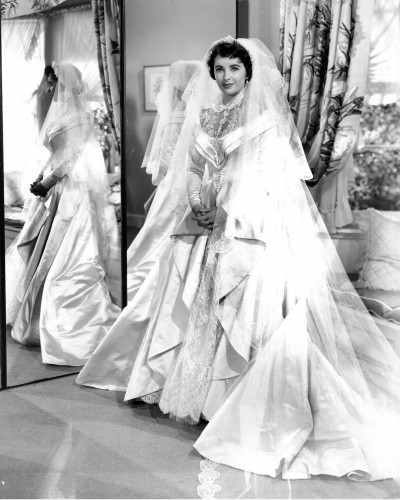
The movie wedding took place in Father of the Bride (1950), with Spencer Tracy playing the father and Joan Bennett playing the mother. The groom was played by an unknown actor Don Taylor, although his parents were the veteran actors Billie Burke and Moroni Olsen. The movie was a hit, the box office smash helped by Elizabeth’s real wedding to Conrad “Nicky” Hilton on May 6, 1950, just before the film’s release. And of course Elizabeth had wanted Helen to design her own wedding gown, similar to the one she would be wearing in Father of the Bride. And MGM even made Elizabeth a gift of the wedding gown, not a small matter since it took fifteen seamstresses and embroiderers three months to make it.

Elizabeth’s wedding gown as it appeared in preparation for auction by Christie’s in 2013, where it fetched $188,000. The gown was made of 25 yards of ivory silk satin, with “illusion” lace shoulders and all-over embroidered decorations of bugle beads and seed pearls. The gown was previewed by good friend and fellow blogger Kimberly Truhler before it went to Christie’s London. She confirmed that the level of craftsmanship was so high for the gown that it would be virtually impossible to duplicate it today.
And so with Helen’s beautiful wedding gown designs for both Father of the Bride and Elizabeth’s wedding that preceded its release by a month, Helen Rose was constantly in the news as the “it” wedding gown designer. Indeed, she would go on to design Grace Kelly’s wedding gown to Prince Ranier, an even more elaborate marvel of dressmaking, and again made at the MGM wardrobe Department.
In 1952 Love is Better Than Ever, was finally released, directed by Stanley Donen. Elizabeth was cast opposite Larry Parks, who had been blacklisted, which resulted in delaying the release of the movie. Elizabeth was at the peak of her youthful radiance, and was here playing a dance teacher attending a convention in New York and engaging in a romance with a confirmed bachelor played by Parks. The movie is a light romantic comedy but it captured Elizabeth at a unique point in her ascent to super stardom. Her role in A Place in the Sun had already been shot and released by Paramount in 1951, where she was dressed by Edith Head. Love is Better Than Ever had actually been filmed earlier, and completed in January 1951. Even with the blacklist situation, MGM didn’t want to lose out on the hot streak of the radiant Elizabeth Taylor. Helen Rose here begins to fashion her in the New Look that will dominate most American women’s fashion in the 1950s, especially that of young women and teenagers – a direct result of Elizabeth Taylor’s influence.
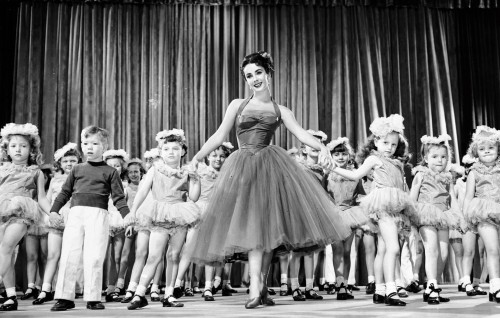
Elizabeth Taylor is shown above with some of her young students and with Larry Parks below in Love is Better Than Ever, where Elizabeth plays a dance teacher.

Helen Rose next designed for Elizabeth in Rhapsody (1954), another musical genre. In this movie she loves a self-obsessed violin player played by Vitorio Gassman while it’s really a pianist played by John Ericson who loves her. While the script and acting are of middling quality, the magneticism of Elizabeth Taylor at this stage in her career is riveting. She had a star quality at 22 that is unparallelled.
Helen Rose helped define her look, and for several years thereafter, the look combined a strong sexual appeal within a feminine and tasteful fashion style. Helen’s design elements emphasized Elizabeth’s beautiful shoulders, her small waist developing into a well-defined bust and an evident decolletage, which the still- photographers usually shot from a high vantage point. Helen would also use the silhouette of the New Look to give Elizabeth a long full skirt to further emphasize Elizabeth’s narrow waist and the feminine contour Helen liked.
Elizabeth Taylor is shown with John Ericson below. Helen Rose liked to emphasize Elizabeth’s shoulders. Since this became a focal point, Helen would always pay close attention to the fit and look of the straps on the gowns and dresses she designed. She liked to emphasize the shoulders and she knew they would always be a focus since they were so near the face. She carried this attention to detail for the other actresses she designed for as well.

It was not a musical, but the words and music to the haunting song, The Last Time I Saw Paris, gave both the title and the theme to Elizabeth’s next movie, which co-starred Van Johnson and Donna Reed. Here Elizabeth and Van Johnson play tragic lovers in post-World War II Paris.
One of Helen’s gown designs for Elizabeth caused problems with the censor. It was a red chiffon gown with a deep decolletage and a very low back, a crucial costume for the plot. Apparently while on the set during production the female censor got on a ladder to view the amount of cleavage showing and declared that the gown was “out.” Helen was devastated and the director Richard Brooks was so livid that he cursed up and down the set until the censor. Filming then resumed.
The costume sketch for Helen’s design for the Elizabeth Taylor gown that caused all the commotion in The Last Time I Saw Paris is shown below.
Elizabeth in Helen’s dresses continued to light up the screen in Cat on a Hot Tin Roof, the 1958 movie based on the Tennessee Williams play, co-starring Paul Newman.
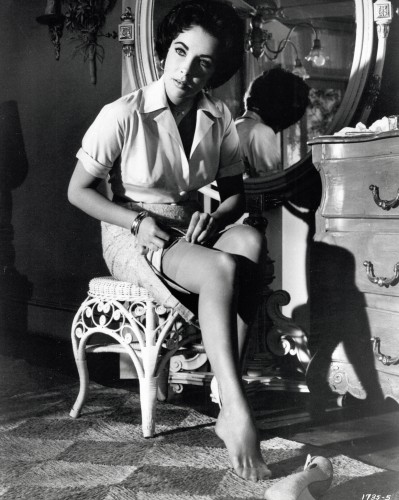
The film is based on the play of the same title. The more than obvious charms-yet failed attempts of Maggie “the Cat” played by Elizabeth to get her husband Brick , Paul Newman, to take her to bed, gets her to say in frustration that she feels like a “cat on a hot tin roof.” The film downplays the play’s more overt homesexual undercurrent, but maintains its mixture of mendacity, lies, jealousy and general “bad blood.” Nonetheless, Helen’s most famous design for Elizabeth, in her effort to entice her husband, has become legend, and was known for many years after as the “Cat dress.”
It is shown below, a Grecian bodice with full but somewhat short white chiffon dress. It became a best seller when she started her own Helen Rose line in 1958.
In Butterfield 8 (1960) Helen designed another costume that became a fahion winner for her own line. The dress was a black chiffon coctail dress with the usual decolletage that Elizabeth wears while seated on top of a bar as shown below. It was costume designer Moss Mabry that suggested it to Gayle and Fred Hayman of the legendary Giorgio’s of Beverly Hills for their store, where it became a best seller from Helen’s line.

But the image that became iconic from Butterfield 8 is that of Elizabeth in a slip with a drink in her hand. In 1960 this was still risque enough to be considered a bold image, especially for the movie advertisements and posters that were produced from it. It’s not so much what the image revealed, as what it implied. We were now entering the 1960s, where movies would be all over the spectrum in their degree of realism. Helen Rose didn’t have to design the slip, it could be found in any department store.

Full length furs were still worn in 1960, convenient for wearing, like a trench coat, directly over a slip when one has nothing else to put on.
Photo courtesy Photofest
This would be Elizabeth Taylor’s and Helen Rose’s last collaboration. At this pont Elizabeth wanted to exit her MGM contract, where she would soon be moving from $125,000 a movie to over a $1 million for Cleopatra.
Helen Rose left MGM in 1966. By that time, long term contracts were no longer being given to studio designers, or other skilled trades. Four years later the studio auctioned off thousands of its costumes, many of which Helen Rose had designed. The film library was sold also. Fortunately we can still see most of these film treasures on TCM and elsewhere.
Views: 1521
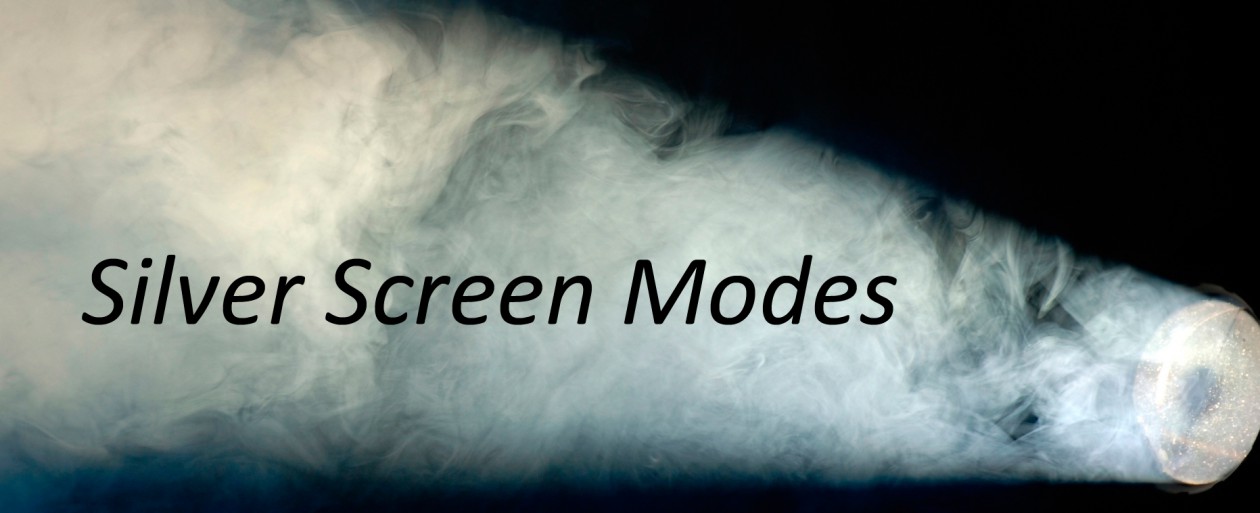




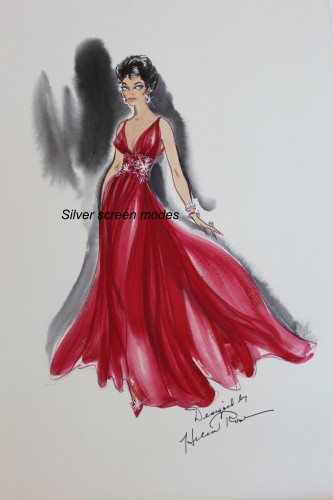


My mother made her first pinafore. This was when Elizabeth arrived to the Chateau Marmont in Hollywood from England.
That’s wonderful. Did your mother work privately for the family or did she ever work for MGM?
What a great post. Thanks for all the dish!
What a fabulous piece! I worked with and was friends with both Helen and Elizabeth – this is se well written and so right on. Thank you!
Thanks for your comment Jorjett. You must have had great times with these great ladies.
Did you by Chance ever work with Shirley Booth, Natalie Schaffer or Herominie Ginghold? Typing sans Glasses so forgive any errer’s please. Updating Tributes I wrote & published on Each. Hoping to locate Others, missed the first time who Might be willing to Share Anecdotes, etc. Respectfully –
Kevin Minton
Larcenywithmusic@gmail.com
So cool
Thanks for noting my error. I removed the image since it no longer pertained to Helen Rose.
=In the photo below, MGM Wardrobe ladies work on Elizabeth’s costume in Rhapsody.=
Thank you for interesting and informative post, but there is one mistake. This photo was made in Rome, and these ladies work on Elizabeth’s gown by Fontana Sisters (famous italian designers). Taylor attended the Academy Awards in 1954 in this gown with Michael Wilding.
She is elegant in true.
Forgive my absence, my friend, as I am only now catching this beautiful post. Of course this designer-star partnership is one of my favorites as well–Helen was a dear friend of Elizabeth’s and she always made her look so feminine and lovely. I love how you show their style evolution together, including her first wedding gown by Helen as well. Thanks for doing such a great job at telling their story. Loved it!
Thanks Kimberly. They worked together for many years, and especially through the time Elizabeth became a woman and a star. I think Helen knew exactly how to dress her for her roles
and her person and personality. We can see the results still although we rarely get to see some of Elizabeth’s earlier movies.
Wonderful review of Helen Rose’s work for Elizabeth Taylor, Christian – and a reminder that the designer created the majority of the star’s truly iconic gowns: the Father of the Bride wedding gown, the white chiffon “Cat dress” and the black cocktail dress for Butterfield 8 (gorgeous but wasted on a mediocre film). Had the stunning red concoction Rose designed for The Last Time I Saw Paris made it past the censors, it would have become legendary, too.
Poor Jane Powell (in the still from A Date with Judy) having to stand beside lovely Elizabeth, a dream in that shoulder-baring yellow gown, in a puffy-sleeved little girl’s dress.
My apologies for a belated post and reply to your comment Lady Eve. Yes, Helen Rose really did develop a partnership with Elizabeth on developing her wardrobe at different stages of her life and career – creating iconic looks along the way.
Thanks for your perceptive comments.
Silver Screen Modes- ELIZABETH TAYLOR & DESIGNER HELEN ROSE http://t.co/n5kuC3z1h9